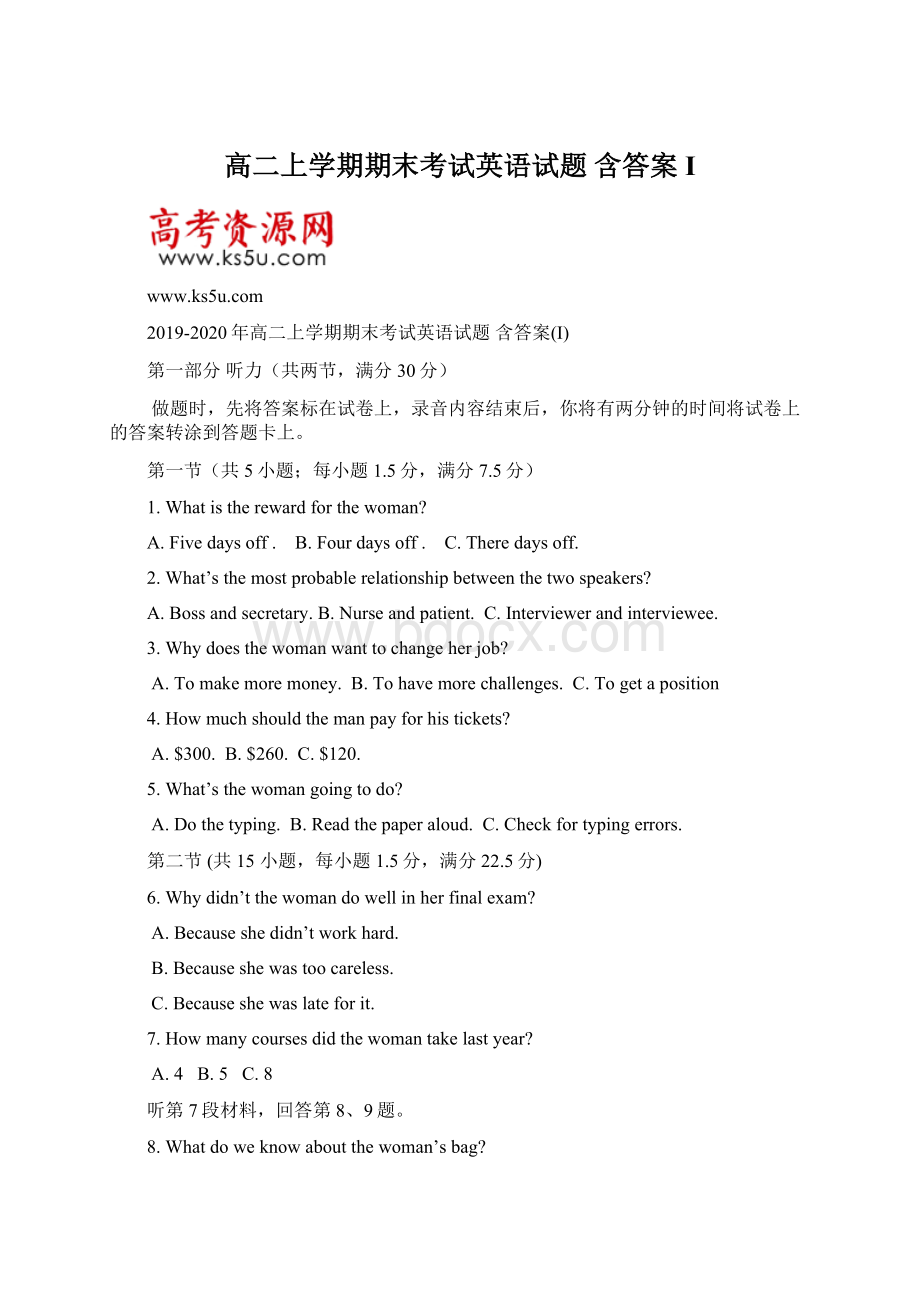高二上学期期末考试英语试题 含答案I文档格式.docx
《高二上学期期末考试英语试题 含答案I文档格式.docx》由会员分享,可在线阅读,更多相关《高二上学期期末考试英语试题 含答案I文档格式.docx(16页珍藏版)》请在冰豆网上搜索。

A.Dothetyping.B.Readthepaperaloud.C.Checkfortypingerrors.
第二节(共15小题,每小题1.5分,满分22.5分)
6.Whydidn’tthewomandowellinherfinalexam?
A.Becauseshedidn’tworkhard.
B.Becauseshewastoocareless.
C.Becauseshewaslateforit.
7.Howmanycoursesdidthewomantakelastyear?
A.4B.5C.8
听第7段材料,回答第8、9题。
8.Whatdoweknowaboutthewoman’sbag?
A.It’ssmall.B.Ithasaziponthefront.C.Ithasapocketontheback.
9.What’sinthewoman’sbag?
A.Atoy.B.Apet.C.Somebooks.
听第8段材料,回答第10至12题。
10.What’sthemostpossiblerelationshipbetweenthetwospeakers?
A.Professorandstudent.B.Bossandemployee.C.Colleagues.
11.Whatreportdidthewomanwrite?
A.Anewsreport.B.Anaccidentreport.C.Anannualreport.
12.Whatisthewomanpossiblyworryingabout?
A.Themanisstillangrywithher.
B.Herreportwillnotpassthrough.
C.Nobodyhelpsherwork
听第9段材料,回答第13至16题。
13.WhydoesthemanwanttoleaveearlythisFriday?
A.Toavoidthetrafficjam.B.Topickuphisfriends.C.Totakeavacation.
14.Whatdayisittomorrow?
A.TuesdayB.Wednesday.C.Friday.
15.WhowillhaveapresentationonMonday?
A.Thewoman.B.Theman.C.Areporter.
16.Whatdoesthewomanaskthemantodo?
A.MakeapresentationB.DoasurveyC.Writeareport
听第10段材料,回答第17至20题。
17.Whatisfollowedbytheweatherreport?
A.Amusicprogram.B.Sometrafficnews.
C.AstoryaboutBritneySpears.
18.Whatdoesthespeakersuggestdriversdo?
A.Takeumbrellaswiththem.B.Drivecarefullyandslowly.
C.AvoidtheTokyoTowertonight.
19.Whatwilltheweatherbelikethisweekend?
A.Rainy.B.Cloudy.C.Sunny.
20.Wherewillthespeakerprobablygothisweekend?
A.Totheradiostation.B.Tothepark.C.TotheTokyoTower.
第二部分:
阅读理解(每小题2分共40分)
A
“Ican’tlivewithoutmymobilephone!
”iswhatIoftenhearpeoplesayastheytalkabouthowmobileshavebecomeanessentialpartoftheirlives.
Thesocommonsightofheadsbent,eyesstaringatmobilescreensandfingersbusytappingawayrepeatsitselfacrossmajorcitiesaroundtheworld.Wheneverthereisamomenttosparewhileonthetrain,taxiorwaitinginaqueue,peoplebusythemselveswiththeirmobilephones.
Somepeoplebelieveourunhealthyobsession(着迷)withmobilephonesisdestroyinghowweappreciatethelittlethingsinlifeormissthemomentsthatmatter.Thetruthisthattechnologyoverallshouldbeseenasjustatooltoimproveourlives.
Mobilephoneshavecertainlyhadag
reatinfluenceonourlives,butItrulybelieveitisforthebetter.
It’schangedthewaywecommunicate,whetherforworkorplay.Wearenowlessconstrained(限制)bytimeandgeographicallocation.Withmymobilephone,Icandialintoconferencecallswhilestuckinatrafficjam,orreplytourgente-mailswhileonthego.Icansendatextmessageorsharephotosandvideoswithfriendswhoaren’tlivinginthesamecountry.Myphonecalendarkeepsmylifeorganized,andevenFacebook,Twitter,andinstantmessagingarenowaccessiblefrommobilephones!
Themobilerevolutionisn’tjustchangingthelivesofurbanities(都市人)likemyself.IknowofayoungBangladeshiwomannamedShompaAkhterwhoiscrazyaboutfashionand
design.Shedreamtaboutstartingherownbusinessandshedidjustthat,openingashopinKushtiafeaturingherowncreations.DealingwithsuppliesindifferenttownswasaproblemforShompa---purchaseordershadtoeitherbehanddeliveredormailedouttosupplies.Shompaalsofoundittoughpublicizingherbusinesstopotentialcustomersoutsidehertown.Butonceshelearnttooperatethemobilephone,shewasaddicted.The25-year-oldbusinesswomannowstaysintouch
easilywithhersuppliers.Mobilee-mailisablessinginherlife.
Whowouldhavethoughtthatmobilitycouldbringaboutsuchenormouschange?
Itshouldn’treallybeasurprisethough.
21Inthefirsttwoparagraphs,theauthorwantstoshow____.
A.mobilephonesmakepeoplecommunicateless
B.mobilephonesmakepeople’slifemoreenjoyable
C.people’shealthisgreatlyaffectedbymobilephones
D.peoplebecomeaddictedtomobilephonesind
ailylife
22.What’stheauthor’sattitudetowardsmobilephones?
.
A.DoubtfulB.SupportiveC.CriticalD.Uninterested
23.Paragraph5ismainlyabout__________.
A.ThedisadvantagesofmobilephonesB.NewchangesinInformationAge
C.TheadvantagesofmobilephonesD.Theauthor’spersonalexperiences
24.Howisthetextmainlydeveloped?
A.Byinferring.B.Byanalysingcauses.
C.Bygivingexamples.D.Bycomparingdifferentideas.
B
Areyoulearningaforeign1anguage?
Doyoufinditchallengingtolearnaforeignlanguage?
However,thereareafewtipsyoucanuseinordertoearnatopgrade--aswellasactuallyusetheskillsyou'
velearned.
Oneofthemostimportantandbasiclessonsindealingwithaforeignlanguageistolearnandunderstandeachconceptandlessonbeforemovingontothenextone.Ifyoudon’tunderstandoneconceptbutmoveontothenextchapteranyway,you'
relesslikelytounderstandthenewmaterial.
Learninganewlanguageisnotonlyanacademictool,butcanhelpyouinyoureverydaylifeaswell.Beinggoodatanotherlanguagecanhelpyoucommunicatewithotherpeople,aidyouwhentravelingtoforeigncountries,andevenmakeyourresumelookbetter.
Anditisimportanttolearncorrectpronunciationassoonaspossibleforpoorpronunciationcanbehardtobreak.Nativespeakersofthelanguageaswellasothersfluentinthelanguageyouare1earningwillappreciateyoureffortstolearncorrectpronunciation.
Gatheroutsidematerialssuchasbooks,studyguides,booksontape,andtravelbookstoaidyouinlearningthelanguage.Yourtextbookscan'
tpossiblyteachyoueverythingyouneedtoknow,soseekingout—sidesourcesisgenerallyagoodruleofthumbtokeepinmind.
Asignificantmotivatorinlearningaforeignlanguageistravelingtothecountrywherethelanguageisspoken.Thatway,youcanseefirsthandhowthelanguageisused,learntheculture,andmeetnativespeakersofthelanguage.Nativespeakersappreciatesincereattemptsofotherswhotakethetimetolearntheirlanguage.
Seekoutnativespeakersofyournewlanguageinyourschoolorneighborhood.Theycanhelpyouwithmanyskills,includingpronunciation,andtheycanprovideimmediatefeedbackonyourprogress.
25.Thispassageiswrittento__________.
A.explainwhylearningaforeignlanguageischallenging
B.tellustheimportanceoflearningforeign1anguages
C.tellussomewaysofearningatopgrade
D.giveussometipsonlearningforeignlanguages
26.What'
sthebestsubtitleofParagraph3?
A.Thinkbeyondacademictool.
B.Learneachconcept.
C.Planatriptouseyourskills.
D.Consideralanguageasanacademictool.
27.Wecanlearnfromthepassagethat__________.
A.textbooksarenotgoodforuswhen1earningaforeignlanguage
B.1earningpronunciationwellfromtheverybeginningisveryimportant
C.poorpronunciationcanbeeasytobreakwiththehelpofnativespeakers
D.seekingtoomanyoutsidesourceswillbemoreharmfulthanbeneficial
C
Nexttimeyouhearafunnyjokeyou’dbetternotlaughtoohard.AccordingtoapaperpublishedbytheBritishMedicalJournal,laughterisn’talwaysthebest
medicine.Sometimesitcanevenbeharmful.ProfessorRobinFernerfromtheUniversityofBirmingham,oneoftheauthorsofthestudy,foundthatbadthingscouldhappentopeoplewholaughedtoomuch.Hesays:
“Wefoundpeoplewithheartbeatproblemswhichhadstoppedtheirheart,wefoundpeoplewhohadfainted(昏倒),andwefoundpeoplewho’d
dislocatedtheir
jaws
orbursttheirlungs.”
Itseemsthatlaughingcanbe
nolaughingmatter.But
it’snotall
doomandgloom.ProfessorFernersaystherearebenefitstolaughingwhenyouwantto
loseweight,forexample.Yes,that’sright:
laughandbeslimmer!
ProfessorFernerexplainsthat:
“Youuseenergywhenyoulaugh,youmoveyour
diaphragm(横膈膜),youexpandyourlungs,andboththosethingscanbehelpful.”
Accordingtotheresearch,laughingforaquarterofanhourcanburnupto40calories,andifyoulaughedalldayyou’duseupabout2,000calories,whichiswhatmostpeopleconsumeinaday.Butdon’tdothatoryoumightendupwitha
painful
jaw.
Ouch!
Oryoumightfindpeoplelookingatyouina
funny
way.
ButIdon’twanttofinishthisarticleleavingyoufeeling
desperate.Laughtercomesnaturallyformostofus.Babiesbegintolaughataround3-6months.Sogiveintoyour
senseofhumour
andkeepsmiling.Lifeisshortanyway.
28.LaughingtoomuchmaycausethefollowingharmfulresultsEXCEPT_________.
A.heartstopB.diaphragmmovement
C.lungburstD.jawdislocation
29.Theunderlinedphrase“doomandgloom”inParagraph2probablymeans_______.
A.hopelessB.funnyC.painfulD.nervous
30.Howmanycaloriescanyouuseifyoulaughforhalfaday?
A.About40.B.About1,000.C.About2,000.D.About2,040.
31.Whatistheauthor’sattitudetowardslaughing